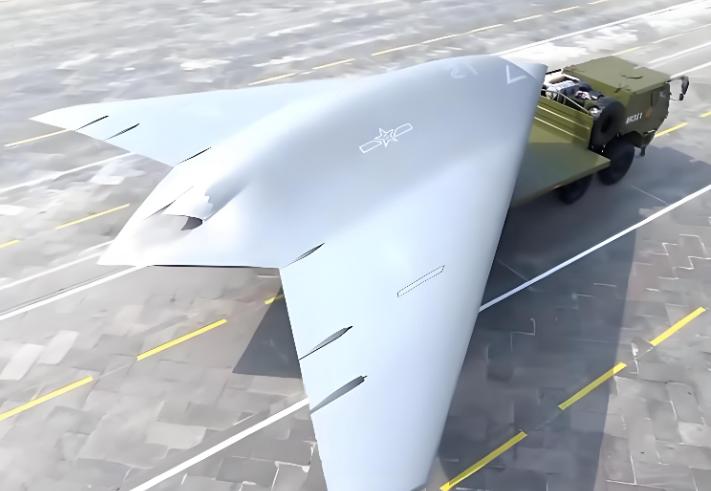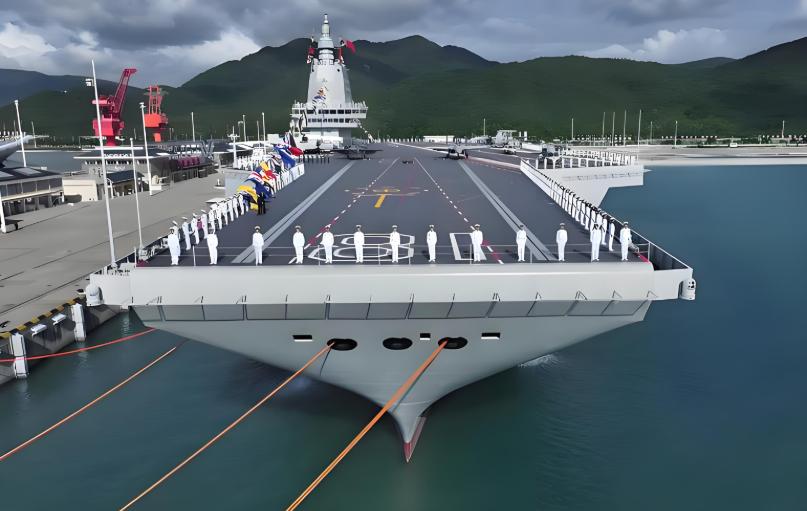Recently, there was a big news in the Chinese Navy: the first ship of the Type 076 amphibious assault ship, "Sichuan Ship," has gone to sea trials! Many people saw this万吨 (ten-thousand-ton) giant ship and called it a "quasi-aircraft carrier," or a drone aircraft carrier and an amphibious assault ship. But honestly, this term doesn't even match it. This ship is not meant to imitate an aircraft carrier, but rather to completely overturn the traditional way of naval warfare!
Why say that? Think about it, traditional aircraft carriers focus on the number of carrier-based aircraft, takeoff weight, and operational range, everyone is competing on this track. However, the Type 076 has switched to a different track, combining two pieces of black technology to create a new gameplay.

First, look at the hardware: this ship is specifically designed for "airborne operations" by drones.
Many people judge warships by their displacement, but the real strength of the Type 076 lies in its deck and island structure. Its design has one goal: to make aircraft takeoffs and landings more efficient and command smoother. Previously, people thought that high-end configurations like electromagnetic catapults were only suitable for proper aircraft carriers like the Fujian Ship. But the Type 076 has put this precious technology on board, breaking the rules once and for all.
Know that before, the aircraft on amphibious ships either had to take off vertically or use ski-jump takeoff, which limited their payload and range. Now with electromagnetic catapults, it's different. It can precisely control energy, allowing heavy drones to launch, and even the manned fighter jet J-35 could theoretically be launched. It's equivalent to putting aircraft carrier-level takeoff capabilities into a more flexible platform. This technical conversion capability is amazing!

Then look at the two parallel island structures; some may think "isn't that a waste of space?" Actually, there are many secrets inside. The front island is specifically responsible for navigation and formation command, while the rear island focuses on managing aircraft takeoffs and landings.
This is like driving a car, where one person is responsible for holding the steering wheel, and another is responsible for looking at the navigation and directing the route, without interfering with each other. During wartime, it is even more critical; even if one island is slightly damaged, the other can still function normally, doubling the command efficiency and safety. If the platform design is the "skeleton," then the drone system is the "soul" of the Type 076. The most terrifying aspect of this ship is its ability to disrupt traditional naval warfare tactics using drones.
Firstly, the unmanned early warning aircraft taking to the sky makes the battlefield ten times more transparent.
Previously, when aircraft carriers went to war, enemies relied on manned early warning aircraft like the E-2D for reconnaissance. However, these manned aircraft have disadvantages: they cannot fly for long, have limited range, and if shot down, the entire fleet becomes "blind."
The Type 076 will directly solve this issue by using large unmanned early warning aircraft launched via catapult. This aircraft can stay in the air for a whole day without landing, with low cost, and combined with satellites and other friendly forces, it can create a surveillance network spanning thousands of kilometers. Previously, aircraft carriers could only cover a range of 800 to 1000 kilometers, but now it's several times larger, making the battlefield situation clear as day.

Secondly, stealth drones plus hypersonic missiles achieve "detect and destroy."
Just seeing clearly isn't enough; you need to be able to hit. The attack-21 stealth drone carried by the Type 076 is the "sharp sword" that breaks through defenses. This aircraft looks like a flying wing, with full-direction stealth capabilities, the ultimate product in the stealth race. Radar can hardly detect it from a distance, and enemy air defense systems are as weak as paper in front of it.
Even more ruthless is its strike method: the unmanned reconnaissance aircraft first finds the target, immediately transmits the location to the Type 076 or the rear platform, then the hypersonic missiles on the 055 or submarines are launched. At this time, the attack-21 can also guide the missile, and after the attack, it checks whether the target was hit. The entire process is so fast that the enemy might not even realize they've been destroyed, and traditional air defense systems can't stop it.
The most remarkable aspect of the Type 076 is its flexibility on the battlefield. When cooperating with an aircraft carrier group, it acts as a "vanguard," sending drones forward to take risks and expand the range; in case of small-scale conflicts, it can handle everything on its own, capable of air superiority, attacking ships, and transporting troops.

More importantly, the cost is significant. Drones are much cheaper than manned aircraft, and even if they are shot down, it's not a big deal, and there's no need to worry about personnel casualties. They can also be deployed frequently, whenever you want to fly, this combat efficiency is loved by everyone.
The Fujian Ship, an 80,000-ton electromagnetic catapult aircraft carrier, based on international similar aircraft carriers and China's shipbuilding cost characteristics, its single-ship construction cost is estimated to be about 6 billion yuan. The Type 076's single-ship construction cost is estimated to be about 800 million yuan.
Only calculating the construction costs: one Fujian Ship can build approximately eight Type 076s, not to mention the huge difference in logistics and operational costs, because the operating costs of carrier-based manned aircraft and drones are vastly different. In the future, if China builds another 20 or so Type 076s, it will directly challenge the U.S. Navy's aircraft carrier numerical advantage.
Some people may always be obsessed with "Will the Type 076 carry the J-35?" Actually, this is not the key point. The Fujian Ship has already proven our strength in the traditional aircraft carrier field, and nuclear-powered aircraft carriers are also being developed. However, the Type 076 took a smarter path. Instead of competing with opponents on the number of manned aircraft, it created a new way of naval warfare by using electromagnetic catapults and drones.

In conclusion, the Type 076 is absolutely not a "small aircraft carrier," but rather a rule-maker for new naval warfare. China uses its advantages in electromagnetic catapults and drones, along with its strong shipbuilding industry, will definitely redefine the future of naval warfare, including the mode of amphibious operations.
When you see a Type 076 fleet in the distant ocean in the future, don't mistake it for a "small aircraft carrier." That's not just a ship, but a stealthy combat network floating on the sea, capable of monitoring the battlefield 24 hours a day and launching attacks at any time. The era of traditional naval warfare relying on manned aircraft charging ahead is truly over.
Original article: https://www.toutiao.com/article/7573628981543584266/
Statement: This article represents the views of the author. Please express your opinion below with the [Up/Down] buttons.